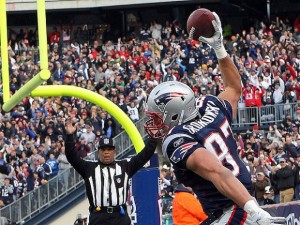Winslow produced solid numbers, but he did so in the worst of circumstances. During this time, his quarterbacks were mostly Josh Freeman and Derek Anderson, along with a season of Charlie Frye, and a few games from Josh Johnson, Brady Quinn, and end-of-career Byron Leftwich. On average, Winslow’s offenses were 0.87 ANY/A below average during the course of his career, weighted by how productive Winslow was each season. Among tight ends with at least 5,000 career receiving yards, that is — by a large measure — the worst group of passing offenses. The second-worst would be Todd Heap: About a quarter of his career came with the early days of Joe Flacco, and another quarter was defined by the Kyle Boller era. He caught passes from end-of-career Steve McNair, Anthony Wright, Jeff Blake, Chris Redman, Elvis Grbac, and also Kevin Kolb and John Skelton in Arizona. On average, Heap’s offenses finished 0.45 ANY/A below average.
Only three other tight ends with 5,000+ career receiving yards played on teams that finished at least 0.20 ANY/A below average: Rich Caster (who had a little bit of prime Joe Namath and then little else), Delanie Walker, and Greg Olsen. If you want to lower the threshold for tight end production, we should all feel badly for Chargers TE Freddie Jones, who played with Ryan Leaf and a string of bad quarterbacks who were either bad, very young, or very old (or two of those three). For his career, Jones’s passing offenses finished 1.46 ANY/A below average. We can also pour one out for Boston Patriots TE Jim Whalen, who was one of the best tight ends of the late ’60s. In 1968, as the Patriots finished with the second-worst passing offense in the AFL — the passing offense was 2.88 ANY/A below average — Whalen somehow was a first-team AP All-Pro. Among all tight ends who have been named first-team All-Pro in a season, that is the worst accompanying passing offense in history. Whalen was a consummate Massachusetts man: he was born and raised in Cambridge, starred at Boston College, and then was drafted and spent the first five years of his career with the Patriots. That said, most of his career was played with bad or out of their prime quarterbacks.
On the other side, Brent Jones had a pretty sweet set-up: he played most of his career with Steve Young or Joe Montana, and his average offense had a Relative ANY/A of +2.00. Second on the list would be Rob Gronkowski, who of course played with Tom Brady. And if you lower the minimum threshold, nobody had it easier than Aaron Hernandez, who played his entire, short career during Brady’s prime.
I looked at the careers of over 100 tight ends and calculated how productive their average passing offense was. Regular readers may recall that I previously used a similar methodology to grade wide receivers. Let’s use Vernon Davis as an example. He’s experienced it all, from the early struggles of Alex Smith to the efficient version, the dark days of Shaun Hill and Troy Smith, but also the good days of Colin Kaepernick and Kirk Cousins. [continue reading…]




